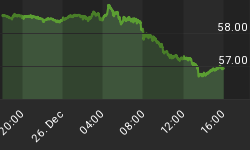
![]() Larger Image - Source: www.sharelynx.com
Larger Image - Source: www.sharelynx.com
With the improvement in gold prices and the gold stocks since the beginning of 2014 there has also been an improvement in sentiment. The above chart illustrates the improvement in the gold sentiment as a ratio chart with the global stock market. It tells an interesting story given that the above chart goes back to 1984.
First some definitions. The global sharemarket index is an index compiled from market indices around the world. The index has 17 components and is arithmetically averaged in order to give them equal weighting. The 17 components are the - Dow Jones Industrials (DJI), Dow Jones Transportations (DJT), Dow Jones Utilities (DJU), NYSE, S&P 500, NASDAQ, Russell 2000, Hong Kong HSI, Japan Nikkei 225, Singapore STI, Australian AORD, TSX Composite 300, Mexico IPC, FTSE 100, Paris CAC, German DAX, and, Swiss SMI. The index is used to show global sentiment towards the world's stock markets. As can be seen global sentiment towards stocks has been rising and has now exceeded peaks seen in 2000 and 2007.
Similarly the gold sentiment index has been compiled from a number of datasets of precious metals, gold indices, gold stocks and gold mutual funds from four primary gold producing regions including - USA, Australia, Canada and South Africa. Oddly, the world's largest producer, China, is not included. Precious metals included are - gold, silver and platinum; indices included are - XAU, HUI, GOX, CRB, GSCI, GPX, TGD, Oz Gold, and, SA Gold; stocks included are ABX, AU, GFI, GG (G in Canada), KGC (K in Canada), and NEM; and, mutual funds included (all US funds) - BGEIX, FSAGX, LEXMX, USERX, and, USAGX. As with the stock index the 29 components are arithmetically averaged to give them equal weighting. Global gold sentiment has been falling since peaking in 2011 although it has recently perked up.
What is interesting is when they are shown as a ratio. It is fiat/gold ratio as it is a comparison between stock market sentiment (fiat) and gold sentiment (gold). The recent peak in the ratio was close to the peak seen in 2001 when gold was trading near $250. This was in some ways surprising as the ratio was fairly steady throughout the 1980's and until 1996 when the ratio rose sharply as the dot.com bubble took off.
After falling from 2000 to 2002, the ratio was relatively steady throughout most of the decade and not far off the levels seen from 1984 to 1997. There was a small spike during the financial crash of 2008. The ratio really took off in 2013 when the gold market and the stock markets went in opposite directions. Since peaking at the end of 2013, the ratio has been falling although it does not yet appeared to have broken the uptrend. A breakdown under 50 on the ratio would probably indicate that the market has swung more in favour of gold over stocks. The ratio is certainly worth keeping an eye on.
The second chart is not so much a sentiment index for gold as a measurement of gold's relative value. The James Turk Fear Index was developed by James Turk www.fgmr.com back in the 1980's as a measurement of gold's relative value. The Fear Index compares the amount of gold held by a country's central bank times the current gold price with the money supply of the country. The chart presented below is the Fear Index for the US Dollar.
The US gold reserves are are held by the Federal Reserve in Fort Knox (or least that is what is advised as being held). The Federal Reserve no longer reports M3 but the numbers are available through Shadow Stats www.shadowstats.com. M3 is composed of M1 - notes and coins in circulation, and demand deposits of banks; plus M2 - M1 plus savings accounts and time deposits less than $100,000, money market deposit accounts; plus large time deposits over $100,000,institutional money market funds, short term repurchase agreements and other large liquid assets.
When the Fear Index is rising, there is concern about the safety and stability of the country's monetary and banking system. When there is confidence, the Fear Index falls. The Fear Index has been in an uptrend since 2001. Interestingly the current correction in gold has taken the Fear Index back to the rising trendline. If the Fear Index were to break back under the rising trendline then it might be signaling the end of the gold bull. However, if the Fear Index rises off the trendline then the index could rise to new highs as was seen in 1977 following a somewhat similar sharp correction in the index.
The Fear Index is an interesting measurement of gold's value and its trend. It is different from the sentiment indicators but it is one worth keeping an eye on for clues as the future price of gold.

![]() Larger Image - Source: www.sharelynx.com
Larger Image - Source: www.sharelynx.com
















